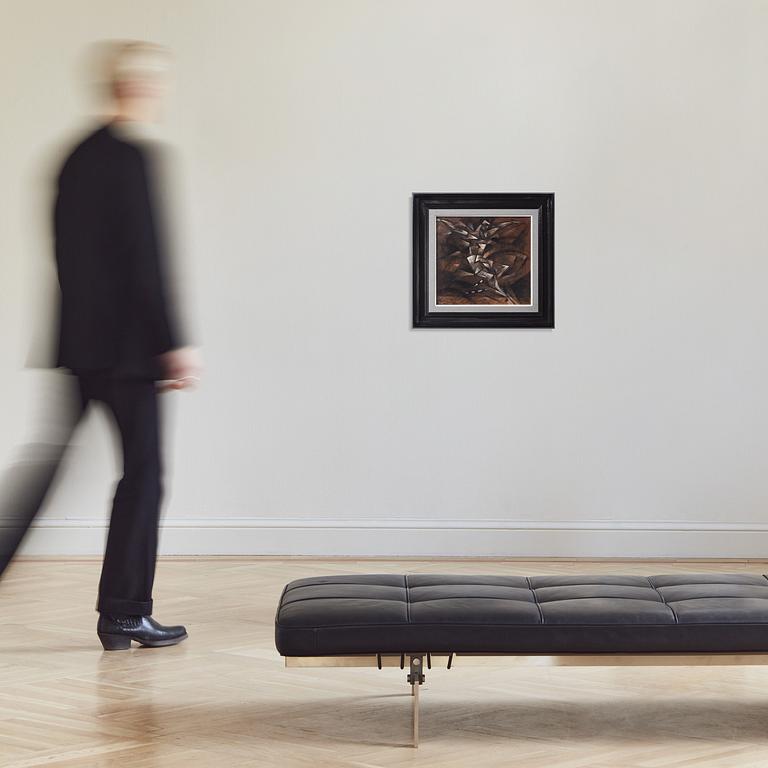Gösta Adrian-Nilsson
"Höjdhoppare"
Signed G. A-N and dated -13 but probably executed in 1914-15. Oil on panel 37.5 x 40 cm.
Alkuperä - Provenienssi
Chief Engineer Edvin Ganborg, Norrköping.
Thereafter by descent to the current owner.
Näyttelyt
Svensk-Franska Konstgalleriet, Stockholm, "GAN - Retrospektiv utställning 1913-1953", September 1953, cat. no. 1.
Malmö Museum, "GAN", 1 - 23 October, 1955, cat. no. 3.
Riksutställningar, "Från Josephson - Svanberg", cat. no. 21.
Liljevalchs konsthall, Stockholm, ”GAN, Gösta Adrian-Nilsson - retrospektivt”, 29 March - 27 April 1958, cat. no. 7.
Lunds konsthall, "GAN och Wiwen Nilsson", 3 July - 28 August 1977, cat. no. 16.
Liljevalchs Konsthall, Stockholm and Malmö Konsthall, "GAN 1884‑1984", 6 April - 20 May, 29 June - 26 August 1984, cat. no. 10.
Mjellby Konstgård, Halmstad, "Gösta Adrian-Nilsson perioden 1914-1932", 5 May - 4 August, 2002, cat. no. 1.
Prins Eugens Waldemarsudde, Stockholm, "Gösta Adrian-Nilsson (GAN) - Modernistpionjär och outsider", 19 February-29 May 2011, cat. no. 7.
Moderna Museet
Kirjallisuus
Nils Lindgren, "Gösta Adrian-Nilsson", 1949, illustrated in black and white on p. 42.
Jan-Torsten Ahlstrand, "Gösta Adrian-Nilsson - Modernistpionjären från Lund 1884-1920", 1985, illustrated in black and white on p. 47.
Mjellby Konstgård, Halmstad, exhibition catalogue "Gösta Adrian-Nilsson perioden 1914-1932", 5 May - 4 August, 2002, illustrated and mentioned s. 14.
Muut tiedot
Gösta Adrian-Nilsson (GAN) was the only artist of importance in the Swedish avant-garde who studied in Berlin rather than Paris before the 1914-1918 World War. In Berlin he got to know Herwarth Walden, the dynamic director of the magazine and gallery Der Sturm, and was deeply influenced by the new modernist art exhibited at the gallery. His strongest impressions came from Der Sturm's general survey of the European avant-garde in the great epoch-making exhibition Erster Deutscher Herbstsalon in the autumn of 1913, where GAN encountered at a stroke French Cubism, Italian Futurism and the Expressionism of the Der Blaue Reiter group, with Vassily Kandinsky and Franz Marc as the leading names, which more than anything else inspired him to change his artistic paradigm. This was not done in a flash, and it was not until the turn of the year 1913/14, when he was at home in Lund celebrating Christmas, that he painted what was probably his first purely modernist painting, ‘Elektrikern’, about which GAN connoisseur Jan Torsten Ahlstrand writes the following: ‘Regardless of whether the painting is an authentic portrait of an electrician or not, it is both stylistically and in terms of content an extraordinarily interesting GAN painting. "Elektrikern" (The electrician) is a portrait of the new man of the age in a futuristic spirit, a man of strong will and determination who, like a seer, looks into the future that belongs to him and the new technology.’ (GAN, Gösta Adrian-Nilsson, Signum, 1985, p. 46)
The period of starvation in Berlin ended happily for GAN in the summer of 1914 in Cologne, where he had been employed as an ‘künstlerischer Erklärer’, a kind of manager, in the architect Bruno Taut's famous Glashaus at the Deutscher Werkbund's major art industry exhibition. But his employment ended abruptly when the entire exhibition was closed on 5 August due to the outbreak of war at the beginning of that month. A message arrived from Berlin: ‘Sie können fahren wohin Sie wollen, die Sache ist erledigt’, GAN wrote many years later in his memoirs.
It was an adventurous journey home, but in mid-August 1914 GAN was back in Lund, bursting with the impressions of Berlin and Cologne; he had a number of drawings with him, but the documented paintings from his time in Germany are very few. In Lund, GAN rented a room on Idrottsgatan in Väster, the new industrial and labour district. There he could study athletic young sportsmen at Idrottsplatsen, and there he passed the gas bell and a couple of industries on his walks to the railway station in the centre. During the two years 1914-1916, in his small apartment, he created his revolutionary new Futurist-Cubist style, initially with athletes and smoke belching locomotives as his preferred motifs.
Jan-Torsten Ahlstrand writes about the painting in question: ‘The painting “Höjdhoppare”, which is also signed with the year 13, is very different from “Elektrikern". It is almost monochrome in a colour scale of brown, white, grey and black, which feels alien to GAN. These are the restrained colours of analytical cubism. In terms of form, however, it is closer to the movement studies of Futurism. Stylistically, it is related to other pictures of sportsmen from the period 1913-1915. In the autumn of 1914, after returning to Lund, GAN settled in the immediate vicinity of Idrottsplatsen, which must have given him ample opportunities for inspiring studies of athletic young men. Possibly ‘Höjdhoppare’ is from this time and later added to the number 13.’
‘Höjdhoppare' is a very important work in Gösta Adrian-Nilsson's production and has been included in the artist's most important exhibitions. The work has never before been sold at auction.



























































